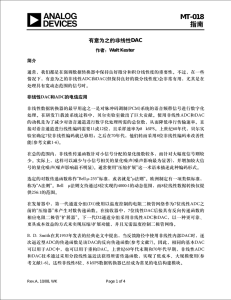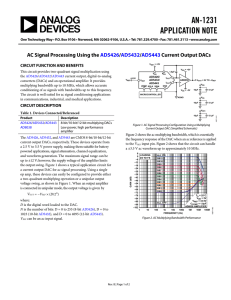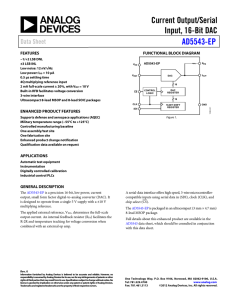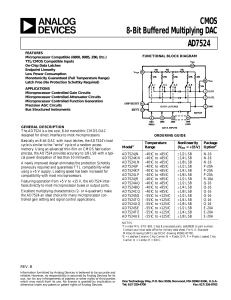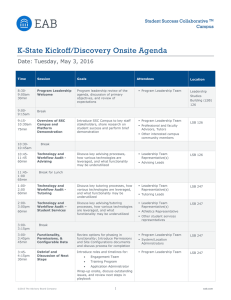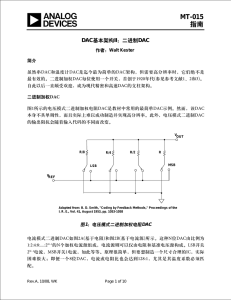a CMOS 12-Bit Monolithic Multiplying DAC AD7541A
advertisement
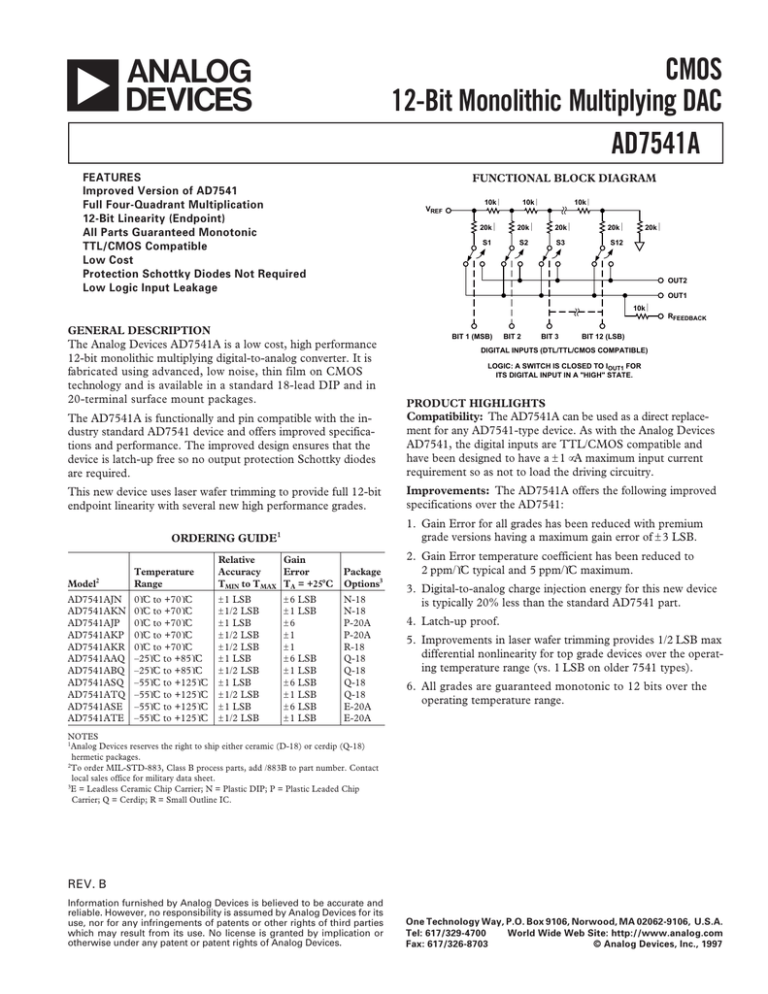
a CMOS 12-Bit Monolithic Multiplying DAC AD7541A FEATURES Improved Version of AD7541 Full Four-Quadrant Multiplication 12-Bit Linearity (Endpoint) All Parts Guaranteed Monotonic TTL/CMOS Compatible Low Cost Protection Schottky Diodes Not Required Low Logic Input Leakage FUNCTIONAL BLOCK DIAGRAM 10kΩ 10kΩ 10kΩ VREF 20kΩ S1 20kΩ 20kΩ S2 S3 20kΩ 20kΩ S12 OUT2 OUT1 10kΩ RFEEDBACK GENERAL DESCRIPTION BIT 1 (MSB) BIT 2 BIT 3 BIT 12 (LSB) The Analog Devices AD7541A is a low cost, high performance 12-bit monolithic multiplying digital-to-analog converter. It is fabricated using advanced, low noise, thin film on CMOS technology and is available in a standard 18-lead DIP and in 20-terminal surface mount packages. PRODUCT HIGHLIGHTS The AD7541A is functionally and pin compatible with the industry standard AD7541 device and offers improved specifications and performance. The improved design ensures that the device is latch-up free so no output protection Schottky diodes are required. Compatibility: The AD7541A can be used as a direct replacement for any AD7541-type device. As with the Analog Devices AD7541, the digital inputs are TTL/CMOS compatible and have been designed to have a ± 1 µA maximum input current requirement so as not to load the driving circuitry. This new device uses laser wafer trimming to provide full 12-bit endpoint linearity with several new high performance grades. Improvements: The AD7541A offers the following improved specifications over the AD7541: DIGITAL INPUTS (DTL/TTL/CMOS COMPATIBLE) LOGIC: A SWITCH IS CLOSED TO IOUT1 FOR ITS DIGITAL INPUT IN A "HIGH" STATE. 1. Gain Error for all grades has been reduced with premium grade versions having a maximum gain error of ± 3 LSB. ORDERING GUIDE 1 Model2 Temperature Range Relative Gain Accuracy Error TMIN to T MAX TA = +258C Package Options3 AD7541AJN AD7541AKN AD7541AJP AD7541AKP AD7541AKR AD7541AAQ AD7541ABQ AD7541ASQ AD7541ATQ AD7541ASE AD7541ATE 0°C to +70°C 0°C to +70°C 0°C to +70°C 0°C to +70°C 0°C to +70°C –25°C to +85°C –25°C to +85°C –55°C to +125°C –55°C to +125°C –55°C to +125°C –55°C to +125°C ± 1 LSB ± 1/2 LSB ± 1 LSB ± 1/2 LSB ± 1/2 LSB ± 1 LSB ± 1/2 LSB ± 1 LSB ± 1/2 LSB ± 1 LSB ± 1/2 LSB N-18 N-18 P-20A P-20A R-18 Q-18 Q-18 Q-18 Q-18 E-20A E-20A ± 6 LSB ± 1 LSB ±6 ±1 ±1 ± 6 LSB ± 1 LSB ± 6 LSB ± 1 LSB ± 6 LSB ± 1 LSB 2. Gain Error temperature coefficient has been reduced to 2 ppm/°C typical and 5 ppm/°C maximum. 3. Digital-to-analog charge injection energy for this new device is typically 20% less than the standard AD7541 part. 4. Latch-up proof. 5. Improvements in laser wafer trimming provides 1/2 LSB max differential nonlinearity for top grade devices over the operating temperature range (vs. 1 LSB on older 7541 types). 6. All grades are guaranteed monotonic to 12 bits over the operating temperature range. NOTES 1 Analog Devices reserves the right to ship either ceramic (D-18) or cerdip (Q-18) hermetic packages. 2 To order MIL-STD-883, Class B process parts, add /883B to part number. Contact local sales office for military data sheet. 3 E = Leadless Ceramic Chip Carrier; N = Plastic DIP; P = Plastic Leaded Chip Carrier; Q = Cerdip; R = Small Outline IC. REV. B Information furnished by Analog Devices is believed to be accurate and reliable. However, no responsibility is assumed by Analog Devices for its use, nor for any infringements of patents or other rights of third parties which may result from its use. No license is granted by implication or otherwise under any patent or patent rights of Analog Devices. One Technology Way, P.O. Box 9106, Norwood, MA 02062-9106, U.S.A. Tel: 617/329-4700 World Wide Web Site: http://www.analog.com Fax: 617/326-8703 © Analog Devices, Inc., 1997 AD7541A–SPECIFICATIONS (V DD = +15 V, VREF = +10 V; OUT 1 = OUT 2 = GND = 0 V unless otherwise noted) Version TA = +258C TA = TMIN, TMAX1 Units All J, A, S K, B, T J, A, S K, B, T J, A, S K, B, T 12 ±1 ± 1/2 ±1 ± 1/2 ±6 ±3 12 ±1 ± 1/2 ±1 ± 1/2 ±8 ±5 Bits LSB max LSB max LSB max LSB max LSB max LSB max All 5 5 ppm/°C max Typical Value Is 2 ppm/°C. J, K A, B S, T J, K A, B S, T ±5 ±5 ±5 ±5 ±5 ±5 ± 10 ± 10 ± 200 ± 10 ± 10 ± 200 nA max nA max nA max nA max nA max nA max All Digital Inputs = 0 V. REFERENCE INPUT Input Resistance (Pin 17 to GND) All 7–18 7–18 kΩ min/max Typical Input Resistance = 11 kΩ. Typical Input Resistance Temperature Coefficient = –300 ppm/°C. DIGITAL INPUTS VIH (Input HIGH Voltage) VIL (Input LOW Voltage) I IN (Input Current) CIN (Input Capacitance) 2 All All All All 2.4 0.8 ±1 8 2.4 0.8 ±1 8 V min V max µA max pF max Logic Inputs Are MOS Gates. IIN typ (25°C) = 1 nA. VIN = 0 V POWER SUPPLY REJECTION DGain/DVDD All ± 0.01 ± 0.02 % per % max DVDD = ± 5% POWER SUPPLY VDD Range I DD All All +5 to +16 2 100 +5 to +16 2 500 V min/V max mA max µA max Accuracy Is Not Guaranteed Over This Range. All Digital Inputs VIL or V IH. All Digital Inputs 0 V or VDD . Parameter ACCURACY Resolution Relative Accuracy Differential Nonlinearity Gain Error Gain Temperature Coefficient2 DGain/DTemperature Output Leakage Current OUT1 (Pin 1) OUT2 (Pin 2) Test Conditions/Comments ± 1 LSB = ±0.024% of Full Scale ± 1/2 LSB = ± 0.012% of Full Scale All Grades Guaranteed Monotonic to 12 Bits, TMIN to TMAX. Measured Using Internal RFB and Includes Effect of Leakage Current and Gain TC. Gain Error Can Be Trimmed to Zero. All Digital Inputs = VDD . AC PERFORMANCE CHARACTERISTICS These Characteristics are included for Design Guidance only and are not subject to test. VDD = +15 V, VIN = +10 V except where noted, OUT1 = 0UT2 = GND = 0 V, Output Amp is AD544 except where noted. Parameter Version1 PROPAGATION DELAY (From Digital Input Change to 90% of Final Analog Output) All TA = +258C 100 TA = TMIN, TMAX1 — Units ns typ OUT 1 Load = 100 Ω, CEXT = 13 pF. Digital Inputs = 0 V to VDD or VDD to 0 V. nV-sec typ VREF = 0 V. All digital inputs 0 V to VDD or VDD to 0 V. Measured using Model 50K as output amplifier. DIGITAL TO ANALOG GLITCH IMPULSE All 1000 — Test Conditions/Comments 3 MULTIPLYING FEEDTHROUGH ERROR (VREF to OUT1) All 1.0 — mV p-p typ VREF = ± 10 V, 10 kHz sine wave. OUTPUT CURRENT SETTLING TIME All 0.6 — µs typ To 0.01% of full-scale range. OUT 1 Load = 100 Ω, CEXT = 13 pF. Digital Inputs = 0 V to VDD or VDD to 0 V. OUTPUT CAPACITANCE COUT1 (Pin 1) COUT2 (Pin 2) COUT1 (Pin 1) COUT2 (Pin 2) All All All All 200 70 70 200 200 70 70 200 pF max pF max pF max pF max Digital Inputs = VIH Digital Inputs = VIL NOTES 1 Temperature range as follows: J, K versions, 0°C to +70°C; A, B versions, –25°C to +85°C; S, T versions, –55°C to +125°C. 2 Guaranteed by design but not production tested. 3 To minimize feedthrough in the ceramic package (Suffix D) the user must ground the metal lid. Specifications subject to change without notice. –2– REV. B AD7541A Operating Temperature Range Commercial (J, K Versions) . . . . . . . . . . . . . 0°C to +70°C Industrial (A, B Versions) . . . . . . . . . . . . . –25°C to +85°C Extended (S, T Versions) . . . . . . . . . . . . . –55°C to +125°C Storage Temperature . . . . . . . . . . . . . . . . . . –65°C to +150°C Lead Temperature (Soldering, 10 secs) . . . . . . . . . . . +300°C ABSOLUTE MAXIMUM RATINGS* (TA = +25°C unless otherwise noted) VDD to GND . . . . . . . . . . . . . . . . . . . . . . . . . . . . . . . . +17 V VREF to GND . . . . . . . . . . . . . . . . . . . . . . . . . . . . . . . . ± 25 V VRFB to GND . . . . . . . . . . . . . . . . . . . . . . . . . . . . . . . . . ± 25 V Digital Input Voltage to GND . . . . . . . . –0.3 V, VDD + 0.3 V OUT 1, OUT 2 to GND . . . . . . . . . . . . –0.3 V, VDD + 0.3 V Power Dissipation (Any Package) To +75°C . . . . . . . . . . . . . . . . . . . . . . . . . . . . . . . 450 mW Derates above +75°C . . . . . . . . . . . . . . . . . . . . . . 6 mW/°C *Stresses above those listed under Absolute Maximum Ratings may cause permanent damage to the device. This is a stress rating only; functional operation of the device at these or any other conditions above those indicated in the operational sections of this specification is not implied. Exposure to absolute maximum rating conditions for extended periods may affect device reliability. CAUTION ESD (electrostatic discharge) sensitive device. Electrostatic charges as high as 4000 V readily accumulate on the human body and test equipment and can discharge without detection. Although the AD7541A features proprietary ESD protection circuitry, permanent damage may occur on devices subjected to high energy electrostatic discharges. Therefore, proper ESD precautions are recommended to avoid performance degradation or loss of functionality. WARNING! ESD SENSITIVE DEVICE TERMINOLOGY OUTPUT LEAKAGE CURRENT RELATIVE ACCURACY Current which appears at OUTI with the DAC loaded to all 0s or at OUT2 with the DAC loaded to all 1s. Relative accuracy or endpoint nonlinearity is a measure of the maximum deviation from a straight line passing through the endpoints of the DAC transfer function. It is measured after adjusting for zero and full scale and is expressed in % of fullscale range or (sub)multiples of 1 LSB. AC error due to capacitive feedthrough from VREF terminal to OUT1 with DAC loaded to all 0s. DIFFERENTIAL NONLINEARITY OUTPUT CURRENT SETTLING TIME Differential nonlinearity is the difference between the measured change and the ideal l LSB change between any two adjacent codes. A specified differential nonlinearity of ±1 LSB max over the operating temperature range insures monotonicity. Time required for the output function of the DAC to settle to within 1/2 LSB for a given digital input stimulus, i.e., 0 to full scale. MULTIPLYING FEEDTHROUGH ERROR PROPAGATION DELAY This is a measure of the internal delay of the circuit and is measured from the time a digital input changes to the point at which the analog output at OUT1 reaches 90% of its final value. GAIN ERROR Gain error is a measure of the output error between an ideal DAC and the actual device output. For the AD7541A, ideal maximum output is DIGITAL-TO-ANALOG CHARGE INJECTION (QDA) 4095 – 4096 (VREF ). Gain error is adjustable to zero using external trims as shown in Figures 4, 5 and 6. This is a measure of the amount of charge injected from the digital inputs to the analog outputs when the inputs change state. It is usually specified as the area of the glitch in nV secs and is measured with VREF = GND and a Model 50K as the output op amp, C1 (phase compensation) = 0 pF. PIN CONFIGURATIONS 12 BIT 9 BIT 5 8 11 BIT 8 BIT 6 9 10 BIT 7 REV. B BIT 3 7 16 BIT 11 15 BIT 10 14 BIT 9 BIT 4 8 NC RFB VREF OUT 2 OUT 1 VREF RFB NC TOP VIEW (Not to Scale) 20 19 PIN 1 IDENTIFIER GND 4 BIT 1 (MSB) 5 16 BIT 11 TOP VIEW (Not to Scale) BIT 3 7 15 BIT 10 BIT 4 8 9 10 11 12 13 NC = NO CONNECT –3– 14 BIT 9 9 NC = NO CONNECT 18 VDD 17 BIT 12 (LSB) AD7541A BIT 2 6 10 11 12 13 BIT 8 BIT 4 7 BIT 2 6 1 NC TOP VIEW 14 BIT 11 (Not to Scale) BIT 3 6 13 BIT 10 17 BIT 12 (LSB) AD7541A 2 BIT 7 BIT 2 5 18 VDD GND 4 BIT 1 (MSB) 5 3 BIT 5 15 BIT 12 (LSB) PLCC BIT 6 AD7541A 1 20 19 BIT 8 BIT 1 (MSB) 4 2 NC 16 VDD (+) 3 BIT 7 GND 3 OUT 2 17 VREF IN BIT 6 18 RFEEDBACK OUT2 2 BIT 5 OUT1 1 LCCC OUT 1 DIP/SOIC AD7541A APPLICATIONS GENERAL CIRCUIT INFORMATION The simplified D/A circuit is shown in Figure 1. An inverted R-2R ladder structure is used—that is, the binarily weighted currents are switched between the OUT1 and OUT2 bus lines, thus maintaining a constant current in each ladder leg independent of the switch state. 10kΩ 10kΩ UNIPOLAR BINARY OPERATION (2-QUADRANT MULTIPLICATION) Figure 4 shows the analog circuit connections required for unipolar binary (2-quadrant multiplication) operation. With a dc reference voltage or current (positive or negative polarity) applied at Pin 17, the circuit is a unipolar D/A converter. With an ac reference voltage or current, the circuit provides 2-quadrant multiplication (digitally controlled attenuation). The input/ output relationship is shown in Table II. 10kΩ VREF 20kΩ S1 20kΩ 20kΩ S2 S3 20kΩ 20kΩ S12 R1 provides full-scale trim capability [i.e., load the DAC register to 1111 1111 1111, adjust R1 for VOUT = –VREF (4095/4096)]. Alternatively, Full Scale can be adjusted by omitting R1 and R2 and trimming the reference voltage magnitude. OUT2 OUT1 10kΩ RFEEDBACK BIT 1 (MSB) BIT 2 BIT 3 C1 phase compensation (10 pF to 25 pF) may be required for stability when using high speed amplifiers. (C1 is used to cancel the pole formed by the DAC internal feedback resistance and output capacitance at OUT1). BIT 12 (LSB) DIGITAL INPUTS (DTL/TTL/CMOS COMPATIBLE) LOGIC: A SWITCH IS CLOSED TO IOUT1 FOR ITS DIGITAL INPUT IN A "HIGH" STATE. Amplifier A1 should be selected or trimmed to provide VOS ≤ 10% of the voltage resolution at VOUT. Additionally, the amplifier should exhibit a bias current which is low over the temperature range of interest (bias current causes output offset at VOUT equal to IB times the DAC feedback resistance, nominally 11 kΩ). The AD544L is a high speed implanted FET input op amp with low factory-trimmed VOS. Figure 1. Functional Diagram (Inputs HIGH) The input resistance at VREF (Figure 1) is always equal to RLDR (RLDR is the R/2R ladder characteristic resistance and is equal to value “R”). Since RIN at the V REF pin is constant, the reference terminal can be driven by a reference voltage or a reference current, ac or dc, of positive or negative polarity. (If a current source is used, a low temperature coefficient external RFB is recommended to define scale factor.) VDD EQUIVALENT CIRCUIT ANALYSIS The equivalent circuits for all digital inputs LOW and all digital inputs HIGH are shown in Figures 2 and 3. In Figure 2 with all digital inputs LOW, the reference current is switched to OUT2. The current source ILEAKAGE is composed of surface and junction leakages to the substrate, while the I/4096 current source represents a constant 1-bit current drain through the termination resistor on the R-2R ladder. The ON capacitance of the output N-channel switch is 200 pF, as shown on the OUT2 terminal. The OFF switch capacitance is 70 pF, as shown on the OUT1 terminal. Analysis of the circuit for all digital inputs HIGH, as shown in Figure 3 is similar to Figure 2; however, the ON switches are now on terminal OUT1, hence the 200 pF at that terminal. VIN R1* R ILEAKAGE 200pF OUT2 JN/AQ/SD KN/BQ/TD R1 R2 100 Ω 47 Ω 100 Ω 33 Ω ILEAKAGE 200pF ILEAKAGE 70pF 1111 1111 4095 –VIN 4096 1000 0000 0000 2048 –VIN 4096 = –1/2 VIN 0000 0000 0001 0000 0000 0000 1 –VIN 4096 0 Volts OUT2 Figure 3. DAC Equivalent Circuit All Digital Inputs HIGH –4– Analog Output, VOUT 1111 R I/4096 ANALOG COMMON Trim Resistor OUT1 IREF DIGITAL GROUND Table II. Unipolar Binary Code Table for Circuit of Figure 4 RFB 15kΩ AD544L (SEE TEXT) 3 Figure 2. DAC Equivalent Circuit All Digital Inputs LOW R 2 DGND Binary Number in DAC MSB LSB VREF VOUT Table I. Recommended Trim Resistor Values vs. Grades OUT2 I/4096 OUT1 1 AD7541A Figure 4. Unipolar Binary Operation 15kΩ IREF 17 VREF C1 33pF *REFER TO TABLE 1 OUT1 VREF 18 RFB BIT 1 – BIT 12 R 70pF 16 VDD PINS 4–15 RFB ILEAKAGE R2* REV. B AD7541A BIPOLAR OPERATION (4-QUADRANT MULTIPLICATION) Figure 5 and Table III illustrate the circuitry and code relationship for bipolar operation. With a dc reference (positive or negative polarity) the circuit provides offset binary operation. With an ac reference the circuit provides full 4-quadrant multiplication. With the DAC loaded to 1000 0000 0000, adjust R1 for VOUT = 0 V (alternatively, one can omit R1 and R2 and adjust the ratio of R3 to R4 for VOUT = 0 V). Full-scale trimming can be accomplished by adjusting the amplitude of VREF or by varying the value of R5. Figure 6 and Table IV show an alternative method of achieving bipolar output. The circuit operates with sign plus magnitude code and has the advantage of giving 12-bit resolution in each quadrant, compared with 11-bit resolution per quadrant for the circuit of Figure 5. The AD7592 is a fully protected CMOS changeover switch with data latches. R4 and R5 should match each other to 0.01% to maintain the accuracy of the D/A converter. Mismatch between R4 and R5 introduces a gain error. VDD R2* 16 VDD As in unipolar operation, A1 must be chosen for low VOS and low IB . R3, R4 and R5 must be selected for matching and tracking. Mismatch of 2R3 to R4 causes both offset and full-scale error. Mismatch of R5 to R4 or 2R3 causes full-scale error. C1 phase compensation (10 pF to 50 pF) may be required for stability, depending on amplifier used. VIN R1* 17 VREF RFB OUT1 1 AD7541A PINS 4–15 SIGN BIT R2* 16 VDD VIN R1* 17 VREF RFB R5 20kΩ AD544L R6 5kΩ A2 DIGITAL GROUND ANALOG COMMON 10% ANALOG COMMON BIT 1 – BIT 12 DIGITAL GROUND Binary Number in DAC MSB LSB 0 1111 1111 1111 4095 +V IN × 4096 0 0000 0000 0000 0 Volts 1 0000 0000 0000 0 Volts 1 1111 1111 1111 4095 –VIN × 4096 *FOR VALUES OF R1 AND R2 SEE TABLE 1. Table III. Bipolar Code Table for Offset Binary Circuit of Figure 5 Analog Output, VOUT Note: Sign bit of “0” connects R3 to GND. 2047 2048 1111 1111 1111 +VIN 1000 0000 0001 1000 0000 0000 1 +VIN 2048 0 Volts 0111 1111 1111 1 –VIN 2048 0000 0000 0000 2048 –VIN 2048 REV. B SEE TABLE 1. Sign Bit Figure 5. Bipolar Operation (4-Quadrant Multiplication) Binary Number in DAC MSB LSB *FOR VALUES OF R1 AND R2 VOUT AD544J 3 AD544J 1/2 AD7592JN Table IV. 12-Bit Plus Sign Magnitude Code Table for Circuit of Figure 6 A1 OUT2 2 GND 10% AD544L 3 VOUT A2 Figure 6. 12-Bit Plus Sign Magnitude Operation R3 10kΩ OUT1 1 AD7541A PINS 4–15 R4 20kΩ C1 33pF 18 R5 20kΩ R3 10kΩ A1 OUT2 2 GND BIT 1 – BIT 12 VDD R4 20kΩ C1 33pF 18 –5– Analog Output, VOUT AD7541A SINGLE SUPPLY OPERATION Figure 7 shows the AD7541A connected in a voltage switching mode. OUT1 is connected to the reference voltage and OUT2 is connected to GND. The D/A converter output voltage is available at the VREF pin (Pin 17) and has a constant output impedance equal to RLDR. The feedback resistor RFB is not used in this circuit. APPLICATIONS HINTS Output Offset: CMOS D/A converters exhibit a code-dependent output resistance which in turn can cause a code-dependent error voltage at the output of the amplifier. The maximum amplitude of this offset, which adds to the D/A converter nonlinearity, is 0.67 VOS where VOS is the amplifier input offset voltage. To maintain monotonic operation it is recommended that VOS be no greater than (25 × 10–6) (VREF) over the temperature range of operation. Suitable op amps are AD517L and AD544L. The AD517L is best suited for fixed reference applications with low bandwidth requirements: it has extremely low offset (50 µV) and in most applications will not require an offset trim. The AD544L has a much wider bandwidth and higher slew rate and is recommended for multiplying and other applications requiring fast settling. An offset trim on the AD544L may be necessary in some circuits. VDD = +15V NOT USED 1 VREF +2.5V OUT1 18 16 RFB VDD AD7541A 2 OUT2 GND 3 CA3140B VOUT = 0V TO +10V PINS 4–15 4 V– 15 R1 10kΩ Digital Glitches: One cause of digital glitches is capacitive coupling from the digital lines to the OUT1 and OUT2 terminals. This should be minimized by screening the analog pins of the AD7541A (Pins 1, 2, 17, 18) from the digital pins by a ground track run between Pins 2 and 3 and between Pins 16 and 17 of the AD7541A. Note how the analog pins are at one end of the package and separated from the digital pins by VDD and GND to aid screening at the board level. On-chip capacitive coupling can also give rise to crosstalk from the digital-to-analog sections of the AD7541A, particularly in circuits with high currents and fast rise and fall times. V+ VREF 17 R2 30kΩ BIT 1 – BIT 12 VOUT ±V REF D (1 +R2/R1) WHERE 0 ≤ D ≤ 1 i.e., D IS A FRACTIONAL REPRESENTATION OF THE DIGITAL INPUT SYSTEM GROUND Figure 7. Single Supply Operation Using Voltage Switching Mode The reference voltage must always be positive. If OUT1 goes more than 0.3 V less than GND, an internal diode will be turned on and a heavy current may flow causing device damage (the AD7541A is, however, protected from the SCR latch-up phenomenon prevalent in many CMOS devices). Suitable references include the AD580 and AD584. Temperature Coefficients: The gain temperature coefficient of the AD7541A has a maximum value of 5 ppm/°C and a typical value of 2 ppm/°C. This corresponds to worst case gain shifts of 2 LSBs and 0.8 LSBs, respectively, over a 100°C temperature range. When trim resistors R1 and R2 are used to adjust fullscale range, the temperature coefficient of R1 and R2 should also be taken into account. The reader is referred to Analog Devices Application Note “Gain Error and Gain Temperature Coefficient of CMOS Multiplying DACs,” Publication Number E630c-5-3/86. The loading on the reference voltage source is code-dependent and the response time of the circuit is often determined by the behavior of the reference voltage with changing load conditions. To maintain linearity, the voltage at OUT1 should remain within 2.5 V of GND, for a V DD of 15 V. If VDD is reduced from 15 V or the reference voltage at OUT1 increased to more than 2.5 V, the differential nonlinearity of the DAC will increase and the linearity of the DAC will be degraded. SUPPLEMENTAL APPLICATION MATERIAL For further information on CMOS multiplying D/A converters, the reader is referred to the following texts: CMOS DAC Application Guide, Publication Number G872b-8-1/89 available from Analog Devices. Gain Error and Gain Temperature Coefficient of CMOS Multiplying DACs Application Note, Publication Number E630c-5-3/86 available from Analog Devices. Analog-Digital Conversion Handbook—available from Analog Devices. –6– REV. B AD7541A OUTLINE DIMENSIONS Dimensions shown in inches and (mm). 20-Terminal Ceramic Leadless Chip Carrier (E-20A) 0.075 (1.91) REF 0.100 (2.54) 0.064 (1.63) 0.095 (2.41) 0.075 (1.90) 0.358 (9.09) 0.358 (9.09) 0.342 (8.69) MAX SQ SQ 0.200 (5.08) BSC 0.015 (0.38) MIN 3 4 1 0.055 (1.40) 0.045 (1.14) 0.056 (1.42) 0.042 (1.07) 19 18 PIN 1 IDENTIFIER TOP VIEW (PINS DOWN) 8 0.050 (1.27) BSC 8 0.150 (3.81) BSC 0.005 (0.13) MIN 1 9 PIN 1 0.022 (0.558) 0.014 (0.356) 0.070 (1.77) 0.045 (1.15) 10 0.310 (7.87) 0.220 (5.59) 0.325 (8.25) 0.300 (7.62) 0.195 (4.95) 0.115 (2.93) 1 9 PIN 1 0.960 (24.38) MAX 0.200 (5.08) MAX 0.130 (3.30) MIN 0.100 (2.54) BSC 0.098 (2.49) MAX 18 0.280 (7.11) 0.240 (6.10) 0.060 (1.52) 0.015 (0.38) 0.210 (5.33) MAX 0.160 (4.06) 0.115 (2.93) 0.200 (5.08) 0.125 (3.18) 0.023 (0.58) 0.014 (0.36) 0.015 (0.381) 0.008 (0.204) SEATING PLANE 0.100 (2.54) BSC 1 9 PIN 1 0.0118 (0.30) 0.0040 (0.10) 0.4193 (10.65) 0.3937 (10.00) 10 0.2992 (7.60) 0.2914 (7.40) 0.4625 (11.75) 0.4469 (11.35) 18 0.1043 (2.65) 0.0926 (2.35) 0.0291 (0.74) x 45° 0.0098 (0.25) 8° 0.0500 0.0192 (0.49) 0° (1.27) 0.0138 (0.35) SEATING 0.0125 (0.32) PLANE BSC 0.0091 (0.23) –7– 0.060 (1.52) 0.015 (0.38) 0.320 (8.13) 0.290 (7.37) 0.150 (3.81) MIN 18-Lead SOIC (R-18) REV. B 0.110 (2.79) 0.085 (2.16) 18-Lead Cerdip (Q-18) 0.925 (23.49) 0.845 (21.47) 10 0.040 (1.01) 0.025 (0.64) 0.356 (9.04) SQ 0.350 (8.89) 0.395 (10.02) SQ 0.385 (9.78) 18-Lead Plastic DIP (N-18) 18 0.021 (0.53) 0.013 (0.33) 0.330 (8.38) 0.032 (0.81) 0.290 (7.37) 0.026 (0.66) 0.050 (1.27) BSC 14 13 9 0.020 (0.50) R 9 0.025 (0.63) 0.015 (0.38) 3 4 0.028 (0.71) 0.022 (0.56) BOTTOM VIEW 14 13 0.048 (1.21) 0.042 (1.07) 45° TYP 0.088 (2.24) 0.054 (1.37) 0.180 (4.57) 0.165 (4.19) 0.048 (1.21) 0.042 (1.07) 0.100 (2.54) BSC 19 18 20 0.011 (0.28) 0.007 (0.18) R TYP 0.075 (1.91) REF 20-Lead Plastic Leadless Chip Carrier (P-20A) 0.0500 (1.27) 0.0157 (0.40) 0.070 (1.78) SEATING 0.030 (0.76) PLANE 15° 0° 0.015 (0.38) 0.008 (0.20) –8– PRINTED IN U.S.A. C718b–1–6/97
